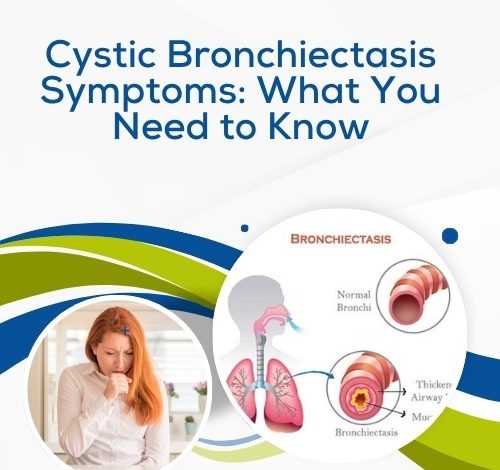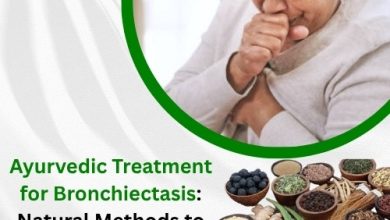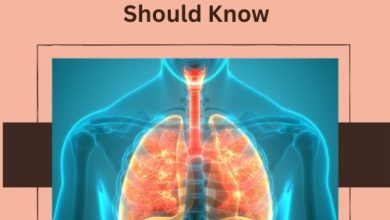Cystic Bronchiectasis Symptoms: What You Need to Know

Bronchiectasis can affect your life in many ways, especially if it’s linked to an underlying condition such as cystic fibrosis. Whether you’re dealing with cystic bronchiectasis or a non-cystic form, the symptoms can be difficult to manage without proper understanding and support. The key signs of cystic bronchiectasis, how they relate to cystic fibrosis, and how symptoms differ in non-cystic cases. You’ll also learn how to spot them early and what to do next.
What is Cystic Bronchiectasis?
Cystic bronchiectasis is a structural change in the airways, most commonly resulting from cystic fibrosis (CF). When mucus builds up due to CF, it traps bacteria and leads to chronic infection and inflammation. Over time, this causes the airways to widen and scar. These changes make it harder for you to clear mucus from your lungs, which increases the risk of repeated infections.
If you’ve received a diagnosis of cystic fibrosis, your risk of developing cystic bronchiectasis is very high. In fact, most people with CF will experience it at some point. You might not notice the symptoms at first, but they tend to get worse without effective treatment.
Common Cystic Bronchiectasis Symptoms
The symptoms can vary depending on the severity of your condition and how well your current treatment plan is working. However, most people experience some combination of the following:
Related Article: Early Symptoms of Bronchiectasis: What You Should Watch Out For
1. Persistent Cough
A chronic, wet-sounding cough is usually the first sign. This isn’t the occasional dry cough you get with a cold. Instead, it produces thick sputum that can be yellow, green, or even streaked with blood during a flare-up.
2. Shortness of Breath
Many people notice they feel breathless even during mild activity, like walking across a room or climbing a few stairs. If you’re coughing up a lot of mucus, it can block your airways and reduce the oxygen your body receives.
3. Chest Pain and Tightness
You may feel an uncomfortable tightness or pain in the chest, especially when coughing. The discomfort often comes from inflamed airways or the strain of constant coughing.
4. Frequent Chest Infections
Cystic bronchiectasis symptoms often include frequent or long-lasting chest infections. You might feel unwell for weeks at a time, and antibiotics may be needed more often than usual.
5. Fatigue
Managing your breathing takes more effort when your lungs aren’t working properly. As a result, many people feel drained, even after a full night’s sleep.
6. Wheezing and Crackles
When listening to your chest, a doctor might hear crackling or wheezing noises. These happen because of trapped mucus and narrowing of the bronchial tubes.
Cystic Fibrosis Bronchiectasis Symptoms: What’s Different?
Cystic fibrosis bronchiectasis symptoms tend to start earlier in life and progress more aggressively than non-cystic forms. Since CF is a genetic disorder that affects the entire body, symptoms go beyond the lungs.
Related Article: End-Stage Bronchiectasis Symptoms: What to Expect and How to Manage Them
If you’re living with CF, you’re more likely to experience:
1. Clubbing of the Fingers
This happens when the ends of your fingers become rounded and enlarged. It’s often a sign of long-term low oxygen levels in the blood.
2. Sinus Issues
Frequent sinus infections, nasal polyps, and blocked nasal passages often occur alongside CF-related bronchiectasis.
3. Digestive Symptoms
CF affects the pancreas, so you may also deal with problems like greasy stools, poor weight gain, or diabetes. These issues can complicate treatment and recovery.
4. Lung Function Decline
People with CF usually face a more rapid drop in lung function. You might need more frequent hospital visits or stronger medications to manage symptoms effectively.
If these cystic fibrosis bronchiectasis symptoms sound familiar, you’ll need a Herbal Treatment for Bronchiectasis that addresses the underlying CF as well as the bronchiectasis.
Non Cystic Fibrosis Bronchiectasis Symptoms
Not everyone with bronchiectasis has cystic fibrosis. In fact, non-CF bronchiectasis is more common in older adults and can develop from other causes like severe pneumonia, tuberculosis, autoimmune disorders, or immune deficiencies.
Related Article: Bronchiectasis Symptoms and Treatment: What You Need to Know to Stay Ahead
The non cystic fibrosis bronchiectasis symptoms often appear later in life and progress more slowly. You might not realise what’s going on until the condition becomes more advanced.
Here’s what to watch for:
1. Chronic Productive Cough
As with cystic bronchiectasis, a long-term wet cough is a major symptom. You may cough up sputum every day for months or even years.
2. Frequent Lung Infections
Non-CF bronchiectasis still leaves you vulnerable to bacteria and viruses. Infections may clear up more slowly or keep coming back.
3. Breathlessness and Reduced Exercise Tolerance
As the airways become more damaged, it gets harder to breathe, particularly when exercising or during infections.
4. Chest Discomfort
Pain or pressure in the chest can be a sign of worsening inflammation. It’s essential to get it checked to rule out complications like collapsed lung or abscess formation.
5. Mild Fever and Weight Loss
Although these signs are less common, they can occur during a flare-up or if the infection spreads. They may also signal another underlying condition.
How to Tell Which Type You Have
Your doctor will use a mix of medical history, imaging scans (such as a high-resolution CT), and sputum cultures to work out whether you’re dealing with cystic fibrosis bronchiectasis symptoms or a non-cystic version.
Related Article: Bronchiectasis Symptoms Explained Clearly: What to Watch For and Why It Matters
A sweat chloride test or genetic testing can confirm CF. If that’s ruled out, other causes will be explored.
You might have already been diagnosed with bronchiectasis, but if your symptoms are changing or getting worse, it’s worth reviewing whether they match the pattern of cystic fibrosis bronchiectasis symptoms.
Why Early Recognition Matters
The sooner you act, the better your chances of controlling the condition and reducing lung damage. People often ignore mild symptoms like a daily cough or occasional breathlessness, but these signs can point to much more serious underlying issues.
Delaying treatment allows infections to do more harm. Over time, your lungs may become less responsive to medications, and your quality of life can decline. Catching non cystic fibrosis bronchiectasis symptoms early can make a real difference.
Related Article: What is Bronchiectasis, and How is It Treated?
Managing Your Symptoms Effectively
If you’ve identified any of the symptoms listed, take steps now to manage them. Whether you’re dealing with cystic fibrosis bronchiectasis or a non-CF form, your care plan should focus on preventing infections, clearing mucus, and maintaining lung function.
1. Airway Clearance Techniques
Physiotherapy and daily airway clearance exercises can help loosen mucus and prevent build-up. Devices like oscillating PEP masks or high-frequency chest wall vests may also be useful.
2. Mucolytics and Inhaled Therapies
Medications that thin the mucus can make it easier to cough up. Inhaled antibiotics or bronchodilators might also be prescribed, depending on your situation.
3. Regular Antibiotic Use
Your doctor may suggest long-term antibiotics to reduce flare-ups. During acute infections, a stronger course may be needed.
4. Vaccinations
Protect yourself from flu, COVID-19, and pneumonia with up-to-date vaccinations. These illnesses can quickly worsen bronchiectasis symptoms.
5. Nutrition and Exercise
Maintaining a healthy weight supports your immune system and improves energy levels. Gentle exercise like walking, swimming, or yoga can help maintain lung function.
When to Seek Help
If you notice any of the following, speak to your healthcare provider:
Related Article: What is the Best Diet for Bronchiectasis?
- Coughing up blood (even small amounts)
- Sharp chest pain that worsens when breathing
- Fever with chills or confusion
- Significant changes in your usual sputum volume or colour
- Sudden worsening of breathlessness
These can signal a serious complication or a need for stronger treatment. Ignoring them could lead to hospitalisation or permanent lung damage.
Living Well With Bronchiectasis
Living with cystic bronchiectasis symptoms means staying alert and proactive. Stick to your treatment plan, attend regular check-ups, and don’t hesitate to report new issues. Support groups and online forums can help you connect with others who understand what you’re going through.
For those with cystic fibrosis, working closely with your CF care team is essential. The right medications, combined with consistent therapy, can delay progression and help you stay active and independent for longer.
And if your condition involves non cystic fibrosis bronchiectasis symptoms, treatment may focus more on treating underlying causes like past infections or immune issues. Either way, you don’t have to face it alone.
Final Thoughts
Understanding the key signs of cystic bronchiectasis can help you take control of your health. Whether you’re experiencing cystic fibrosis bronchiectasis symptoms or dealing with non cystic fibrosis bronchiectasis symptoms, early detection and consistent management are crucial. Don’t wait until symptoms become severe. Act early, seek expert care, and stay informed.




